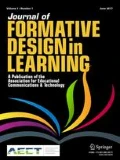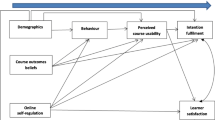Abstract
Massive Open Online Courses (MOOCs) often have low persistence rates, which may be attributed to a learners’ lack of motivation. In this design-based research study, Keller’s Attention, Relevance, Confidence, Satisfaction (ARCS) motivational design model was integrated into two MOOCs as an initial exploration of how to design effective motivational interventions in MOOC environment. The Instructional Motivation Materials Scale (IMMS) was used to measure learners’ perceptions and reactions to the course components, in terms of the ARCS model, in both MOOCs. The whole design, implementation, and evaluation process was documented and reflected upon to provide practical guidance on designing motivational-enhanced materials in MOOC environments. The results revealed patterns of learners selectively paying attention, drawing relevance for self-determined reasons, having high confidence, and deriving satisfaction from multiple sources.
Similar content being viewed by others
References
Belanger, Y., & Thornton, J. (2013). Bioelectricity: a quantitative approach Duke University’s first MOOC (Report). Retrieved from: http://dukespace.lib.duke.edu/dspace/handle/10161/6216.
Burd, E. L., Smith, S. P., & Reisman, S. (2015). Exploring business models for MOOCs in higher education. Innovative Higher Education, 40(1), 37–49. https://doi.org/10.1007/s10755-014-9297-0.
Butler, B. (2012). Massive open online courses: legal and policy issues for research libraries (pp. 1–15). Association of Research Libraries.
Chang, M.-M., & Lehman, J. D. (2002). Learning foreign language through an interactive multimedia program: an experimental study on the effects of the relevance component of the ARCS model. Calico Journal, 20(1), 81–98.
ChanLin, L.-J. (2009). Applying motivational analysis in a Web-based course. Innovations in Education & Teaching International, 46(1), 91–103. https://doi.org/10.1080/14703290802646123.
Evans, B. J., Baker, R. B., & Dee, T. S. (2016). Persistence patterns in massive open online courses (MOOCs). The Journal of Higher Education, 87(2), 206–242. https://doi.org/10.1080/00221546.2016.11777400.
Gerson, S. M. (2000). E-CLASS: creating a guide to online course development for distance learning faculty. Online Journal of Distance Learning Administration, 3(4), 1–18.
Gibson, D., Ostashewski, N., Flintoff, K., Grant, S., & Knight, E. (2015). Digital badges in education. Education and Information Technologies, 20(2), 403–410. https://doi.org/10.1007/s10639-013-9291-7.
Glance, D. G., Forsey, M., & Riley, M. (2013). The pedagogical foundations of massive open online courses. First Monday, 18(5). https://doi.org/10.5210/fm.v18i5.4350.
Guo, P. J., Kim, J., & Rubin, R. (2014). How video production affects student engagement: an empirical study of mooc videos. In Proceedings of the first ACM conference on Learning@ scale conference (pp. 41–50). ACM. Retrieved from http://dl.acm.org/citation.cfm?id=2566239.
Hart, C. (2012). Factors associated with student persistence in an online program of study: a review of the literature. Journal of Interactive Online Learning, 11(1), 19–42.
Hodges, C. B., & Kim, C. (2013). Improving college students’ attitudes toward mathematics. TechTrends, 57(4), 59–66. https://doi.org/10.1007/s11528-013-0679-4.
Hone, K. S., & El Said, G. R. (2016). Exploring the factors affecting MOOC retention: a survey study. Computers & Education, 98, 157–168. https://doi.org/10.1016/j.compedu.2016.03.016.
Huett, J. B., Moller, L., Young, J., Bray, M., & Huett, K. C. (2008b). Supporting the distant student: the effect of arcs-based strategies on confidence and performance. Quarterly Review of Distance Education, 9(2), 113–126.
Jordan, K. (2014). Initial trends in enrolment and completion of massive open online courses. The International Review of Research in Open and Distributed Learning, 15(1). https://doi.org/10.19173/irrodl.v15i1.1651.
Keller, J. M. (1987a). Development and use of the ARCS model of instructional design. Journal of Instructional Development, 10(3), 2–10. https://doi.org/10.1007/BF02905780.
Keller, J. M. (1987b). Instructional materials motivation scale (IMMS). Unpublished Manuscript, The Florida State University.
Keller, J. M. (2006). What is motivational design? (pp. 1–12). Florida: Florida State University.
Keller, J. M. (2008). An integrative theory of motivation, volition, and performance. Technology, Instruction, Cognition & Learning, 6(2), 79–104.
Keller, J. M. (2010). Motivational design for learning and performance: the ARCS model approach (1st ed.). New York: Springer.
Keller, J. M., & Suzuki, K. (2004). Learner motivation and e-learning design: a multinationally validated process. Journal of Educational Media, 29(3), 229–239.
Kelly, A. (2004). Design research in education: yes, but is it methodological? The Journal of the Learning Sciences, 13(1), 115–128.
Kizilcec, R. F., Piech, C., & Schneider, E. (2013). Deconstructing disengagement: analyzing learner subpopulations in massive open online courses. In Proceedings of the Third International Conference on Learning Analytics and Knowledge (pp. 170–179). ACM. Retrieved from: http://dl.acm.org/citation.cfm?id=2460330.
Koper, R., & Olivier, B. (2004). Representing the learning design of units of learning. Journal of Educational Technology & Society; Palmerston North, 7(3), n/a.
Lei, S. A. (2010). Intrinsic and extrinsic motivation: evaluating benefits and drawbacks from college instructors’ perspectives. Journal of Instructional Psychology, 37(2), 153–160.
Li, K., & Keller, J. M. (2018). Use of the ARCS model in education: a literature review. Computers & Education, 122, 54–62. https://doi.org/10.1016/j.compedu.2018.03.019.
Liu, O. L., Bridgeman, B., & Adler, R. M. (2012). Measuring learning outcomes in higher education: motivation matters. Educational Researcher, 41(9), 352–362. https://doi.org/10.3102/0013189X12459679.
Ma, Y., & Harmon, S. W. (2009). A case study of design-based research for creating a vision prototype of a technology-based innovative learning environment. Journal of Interactive Learning Research, 20(1), 75–93.
Masters, K. (2011). A brief guide to understanding MOOCs. The Internet Journal of Medical Education, 1(2). Retrieved from: http://ispub.com/IJME/1/2/10995.
Means, T. B., Jonassen, D. H., & Dwyer, F. M. (1997). Enhancing relevance: embedded ARCS strategies vs. purpose. Educational Technology Research and Development, 45(1), 5–17. https://doi.org/10.2307/30220166.
Nawrot, I., & Doucet, A. (2014). Building engagement for MOOC students: introducing support for time management on online learning platforms. In Proceedings of the companion publication of the 23rd international conference on World wide web companion (pp. 1077–1082). International World Wide Web Conferences Steering Committee. Retrieved from http://dl.acm.org/citation.cfm?id=2580054.
O’Toole, R. (2013). Pedagogical strategies and technologies for peer assessment in Massively Open Online Courses (MOOCs) (Unpublished Discussion Paper). University of Warwick, Coventry, UK: University of Warwick. Retrieved from: http://wrap.warwick.ac.uk/54602/
Ocak, M. A., & Akçayır, M. (2013). Do motivation tactics work in blended learning environments?: the ARCS model approach. International Journal of Social Sciences & Education, 3(4), 1058–1070.
Patton, M. Q. (2002). Qualitative research & evaluation methods (3rd ed.). Thousand Oaks: Sage.
Reeves, T. C. (2000). Enhancing the worth of instructional technology research through “design experiments” and other development research strategies. Presented at the Annual Meeting of the American Educational Research Association, New Orleans, LA, USA.
Richardson, J., & Swan, K. (2003). Examining social presence in online courses in relation to students’ perceived learning and satisfaction. JALN, 7(1), 68–88.
Sankaran, S. R., & Bui, T. (2001). Impact of learning strategies and motivation on performance: a study in web-based instruction. Journal of Instructional Psychology, 28(3), 191–198.
Schunk, D. H. (1990). Goal setting and self-efficacy during self-regulated learning. Educational Psychologist, 25(1), 71–86.
Shapiro, H. B., Lee, C. H., Roth, N. E. W., Li, K., Cetinkaya-Rundel, M., & Canelas, D. A. (2017). Understanding the massive open online course (MOOC) student experience: an examination of attitudes, motivations, and barriers. Computers & Education, 110, 35–50. https://doi.org/10.1016/j.compedu.2017.03.003.
Small, R. V., & Gluck, M. (1994). The relationship of motivational conditions to effective instructional attributes: a magnitude scaling approach. Educational Technology, 34(8), 33–40.
Song, S. H. (2000). Research issues of motivation in web-based instruction. Quarterly Review of Distance Education, 1(3), 225–229.
Starcher, K., & Proffitt, D. (2011). Encouraging students to read: what professors are (and aren’t) doing about it. International Journal of Teaching & Learning in Higher Education, 23(3), 396–407.
Swan, K., & Shih, L. F. (2005). On the nature and development of social presence in online course discussions. Journal of Asynchronous Learning Networks, 9(3), 115–136.
Touré-Tillery, M., & Fishbach, A. (2014). How to measure motivation: a guide for the experimental social psychologist. Social and Personality Psychology Compass, 8(7), 328–341.
Tschofen, C., & Mackness, J. (2012). Connectivism and dimensions of individual experience. International Review of Research in Open & Distance Learning, 13(1), 124–143.
Visser, L., Plomp, T., Amirault, R. J., & Kuiper, W. (2002). Motivating students at a distance: the case of an international audience. Educational Technology Research and Development, 50(2), 94–110.
Wang, F., & Hannafin, M. J. (2005). Design-based research and technology-enhanced learning environments. Educational Technology Research and Development, 53(4), 5–23.
Zheng, S., Rosson, M. B., Shih, P. C., & Carroll, J. M. (2015). Understanding student motivation, behaviors and perceptions in MOOCs. In Proceedings of the 18th ACM Conference on Computer Supported Cooperative Work & Social Computing (pp. 1882–1895). New York: ACM. https://doi.org/10.1145/2675133.2675217
Author information
Authors and Affiliations
Corresponding author
Ethics declarations
Conflict of Interest
The authors declare that they have no conflict of interest.
Appendix
Appendix
-
1.
How many MOOCs are you currently taking? What do you think about them?
-
2.
Why did you sign up for our course?
-
3.
Are you still keeping learning the course?
-
4.
What are your overall opinions on our course site design? What about content presentation and display?
-
5.
What do you think about our course emails (if they answered yes to whether they read the emails)?
-
6.
What do you think about our course pages (if they answered yes to whether they check the course pages)?
-
7.
What are some of the connections you can draw from taking our course and other courses you are taking or your job?
-
8.
While taking the course, do you believe you can learn what you want to learn (or perform as you expected based on their goals stated previously)?
-
9.
What would you feel when you accomplished your goals in this course?
-
10.
Do you want to learn more chemistry-related topics in the future?
-
11.
Please make free comments about any topics we discussed today.
Rights and permissions
About this article
Cite this article
Li, K., Moore, D.R. Motivating Students in Massive Open Online Courses (MOOCs) Using the Attention, Relevance, Confidence, Satisfaction (ARCS) Model. J Form Des Learn 2, 102–113 (2018). https://doi.org/10.1007/s41686-018-0021-9
Published:
Issue Date:
DOI: https://doi.org/10.1007/s41686-018-0021-9




